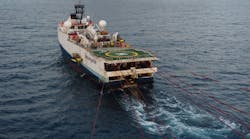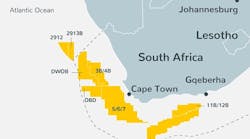Victor Schmidt • Houston
The Society of Exploration Geophysicists explored new technology and advances in practice, along with the future of the profession, at its annual meeting in Dallas. A demographic change that crosses all professional boundaries is approaching the oil industry – the retirement of one generation of professionals and the creation of a new class of professional oil finders.
A panel discussion on "The future of the upstream oil and gas industry" examined the question and the response needed from industry. Two key actions are:
- Industry's refocus to a broad sustainable development agenda
- An outreach effort to tell the industry's positive story to a new generation.
With the average age of geophysicists exceeding 45 years, the need to face the coming "crew change" is critical. Raoul Restucci, CEO of Shell E&P Americas, said the industry is not reaching the science-minded student.
Where will the next generation of oil finders come from? If the traditional oil industry colleges cannot provide the new talent, Restucci says, Shell will find them wherever they exist, from overseas if necessary.
Societies examine growth potential
In a move to improve communication, the International Association of Geophysical Contractors held its first forum at the annual SEG convention in Dallas. The IAGC sees access to acreage as the key issue facing the geophysical contract services industry. If contractors do not have access to acreage, they cannot explore new areas with hydrocarbon potential or re-explore older productive areas.
IAGC brought together a panel to discuss "From prospect to reservoir – cycling through seismic technology." Both the SEG and IAGC see the growth of the geophysical industry tied to reservoir monitoring and the closer integration of reservoir engineering and geophysics.
There are significant challenges in extending the seismic method into field production, including the need to:
- Reduce risk
- Increase efficiency
- Gather higher fidelity seismic
- Improve data integration
- Create timely solutions for complex reservoir issues.
On the SEG exhibit floor, many of the necessary elements for this new direction were being displayed, including in-well monitoring systems, super advanced intelligent tape technology (SAIT) for recording, tape library systems for feeding massively paralleled Linux-driven computer clusters, and visualization systems to display and manipulate the multiple data sets produced by the in-well monitoring systems.
GCAGS sees GoM challenges
The Gulf of Mexico continues to challenge the conceptual thinking of geologists as the industry moves into deeper water, deeper sediments on the shelf, and into new areas off Mexico. Some results of that new thinking were on display at the recent Gulf Coast Association of Geological Societies' annual convention in Baton Rouge, Louisiana.
Speakers noted the dominance of vertical processes in fluid movement throughout the northern Gulf of Mexico due to faulting and salt movement. The dominance of vertical fluid processes means that fluid pressure relationships control the movement of oil and gas.
Evidence was presented showing the development of "sweet spots" between 0.5-0.7 pressure gradients. Sweet spots are common on the shoreward side of diapirs formed near the base of normal listric faults. Ponded sediments on the downward side of the faults help create the diapirs that then focus reservoir sand deposition. These in combination with the fluid pressure regime form traps for hydrocarbons.
The upward movement of hydrocarbon fluids through the sediments has revealed a potential environmental hazard. Concentrated saline solutions expressed from deep seabed vents carry high levels of radium that could become an environmental hazard for seabed operations. The fluids create barite mounds and tubes, similar to carbonate mounds on the shelf, and have accompanying chemosynthetic communities.
On a structural geology note, the Bureau of Economic Geology (Texas) presented a study from the Laguna Madre-Tuxpan Shelf offshore Tampico, Mexico. This north-south trending shelf contains a major fault system, that shows rotation around a point in the southern part of the basin. This sets up very different faulting and structural styles across the basin and has implications for the structural history of the southern GoM.
TECHNOLOGY
Inwell seismic
Weatherford has launched a permanent in-well multi-component optical seismic sensing system called Clarion. The system links seismic investigation and production optimization through a sensor system that can be installed either within production casing or attached to the pipe exterior within the annulus. The company claims specific benefits including:
null
- Production optimization
- Information collection for VSP reservoir imaging, surface seismic calibration, micro-seismic monitoring, cross-well seismic, and seismic-while-drilling
- Permanent field life reliability
- Decreased uncertainty.
The sensor system was developed and field-tested over the past four years.
3D notebook
Sharp Systems of America has released the Sharp Actius RD3D, a notebook computer that incorporates Sharp's TFT 3D liquid crystal display (LCD) technology, which allows viewing of 3D images with the naked eye. Using a parallax barrier, light from the LCD is divided so different patterns reach the viewer's left and right eyes.
null
The notebook is equipped with a 15-in. XGA (1024 x 768) LCD screen and an NVIDIA GeForce 4 440 Go graphic processing unit with 64 Mb of dedicated graphics memory. It uses the Intel Pentium 4 2.80GHz processor and runs under Windows XP Professional. The notebook is equipped with 512 Mb of DDR SDRAM, which scales up to 1,024 Mb and comes with a 60 Gb hard drive. The notebook includes an array of storage and networking options and comes with software to support its 3D and multimedia options.







